 |
ASPO-USA Conference Denver 2009 Trip Report and analysis
In October I attended and was a speaker at the annual Association for the Study of Peak Oil and Gas in Denver, Colorado. Approximately 500 attendees watched 70 speakers present on the geology, economics, and politics of peak oil. In this two-part report I synthesize what I saw.
For readers who are not familiar with the theory, peak oil refers to the process of total world oil production reaching a peak and then declining on a global scale as occurred in net oil exporting countries, such as the U.S. until the 1970s, the UK until the year 2000, and Norway before 2001.
My own interest in the topic started in the early 1970s when I read the 1972 book on energy and resource limits, Limits to Growth. I majored in Natural Resource Studies at the University of Massachusetts in the early 1980s, and later graduated with a BS in Resource Economics. My first iTulip writing on the topic was Energy and Money in March 2006.
I presented at the ASPO conference on the outcome of inflation versus deflation debate, and participated in a panel on energy and the economy with author Kevin Phillips, Adam Robinson of RBS, and Dave Cohen of ASPO. My presentation is available to ASPO members and to iTulip Select members in Part II.
Before we discuss the controversial issues raised at the conference, we review and update the basics of the peak oil argument.
Peak Oil Primer
Robert Hirsch headed the first presentation I attended. In his “train the trainer” session, the audience got an idea of how ASPO-USA wants its members to represent the organization and its key arguments.
Hirsh is a long time energy industry and government policy heavyweight. His resume include Senior Energy Program Advisor at SAIC on World oil production; Senior Energy Analyst, RAND; Vice President of the Electric Power Research Institute; Vice President and Manager of Research and Technical Services for Atlantic Richfield Co.; Founder and CEO of $50 million/year APTI now owned by BAE Systems; Manager of Exxon’s synthetic fuels research laboratory; Manager of Petroleum Exploratory Research at Exxon; Assistant Administrator of the U.S. Energy Research and Development Administration; and by Presidential Appointment, Director of fusion research at the U.S. Atomic Energy Commission and ERDA.
Hirsch wrote a paper in 2008 that quantified how historic declines in world oil supply cause proportionate declines in world GDP. In it he lays out the case for peak oil in a three-scenario framework:
"(1) a Best Case where maximum world oil production is followed by a multi-year plateau before the onset of a monatomic decline rate of 2-5% per year; (2) A Middling Case, where world oil production reaches a maximum, after which it drops into a long-term, 2-5% monotonic annual decline; and finally (3) a Worst Case, where the sharp peak of the Middling Case is degraded by oil exporter withholding, leading to world oil shortages growing potentially more rapidly than 2-5% per year, creating the most dire world economic impacts."
We selected the following slides from his conference presentation that make the peak oil case. Hirsch chooses to begin his train the trainer presentation with one of several unintuitive points in the peak oil argument, that oil does not deplete in a linear fashion, like units of inventory picked off a store shelf as consumers buy them. But if the trainer is speaking to a true lay audience, that observation starts us in the middle of the story.
How many readers understand where oil came from or how utterly unique and irreplaceable petroleum liquid fuels are as a transportation energy source? Very few. So we begin the story here.
Gasoline and diesel, distillates of crude oil, are unique as a liquid fuel. The amount of work a gallon of these fuels can do when by volume burned simply defies imagination. Consider the most mundane act of the automobile owner, stopping off at a gasoline station to refuel. A mere ten gallons of gasoline propels a two-ton vehicle hundreds of miles up and down hills at speed in excess of 60 miles per hour. Try pushing your car ten feet on a flat driveway and you will begin to appreciate how much work the gasoline in your tank is doing. The amount of work a liquid fuel can do by volume is referred to as its energy density. Liquid hydrogen, by comparison, has less than one third of the energy density of gasoline. That means that you need three times as much by volume to travel the same distance, assuming both the gasoline and hydrogen powered engines deliver the same number of miles per gallon.
You can pour the gasoline into your tank on a hot summer’s day or in winter when the temperature is well below zero. Crude oil can be shipped through pipes over long distances in a wide range of temperatures and climates.
Crude oil, and its distillates, is the one and only substance like this. No other liquid that humans can dig out of the ground, refine, and pour into a tank at any climate on earth even comes close. Every other liquid fuel, such as liquid hydrogen, has to be manufactured out of something else, then compressed, and if stored as a liquid kept at temperatures hundreds of degrees below zero. You cannot transport any other fuel through hundreds of miles of pipelines. Crude oil and its distillates can be piped over long distances at a wide range of naturally occurring temperatures, and stored cheaply in unpressurized tanks.
We are using up this unique and irreplaceable liquid fuel source several million times faster than it was created by nature hundreds of millions of years ago. In a little more than two human life spans can we have used up half of all of the oil that took several million human life spans to accumulate.
To compare the ancient rate of oil creation to the modern rate of oil consumption, imagine an abandoned cast iron bathtub resting in a mythical forest. In this forest crude oil drips from the trees. In fact, all of the oil from all of the oil dripping trees hanging over the tub in this magical forest drips into this single iron bathtub.
The oil drips so slowly that it takes 16 years, or five million seconds, to fill the tub.
Each second represents one year of original crude oil creation that happened through biological processes that took place over approximately 500 million years. But rather than trees dripping oil, imagine a flotilla of tiny plants matted the surface of millions of square miles of steamy primordial seas. This floating mass turned a blazing sun, unfiltered by the rich atmosphere we have today, and ocean minerals into trillions of tons of oily plant matter.
As new plants grew on the sunny side of the massive floating mat, old plants died and drifted to the bottom ocean floor. There the oil-soaked material collected and decomposed, forming in pools and crevices as large as lakes. These folded and kneaded as the continents shifted, forming underground caverns filled with oil and gas like so much buried treasure, waiting to be discovered.
The crude oil we burn today is nature’s prehistoric bio-fuel.
About one hundred years ago, humans figured out a use for the crude oil that seeped to the surface of the ground above oil reservoirs far below. We could use it in internal combustion engines to fuel machines that transport food, goods, and ourselves. But how much oil is there for us to use this way?
Our simple analogy of a rusty iron bathtub full of oil represents the whole of it, all of nature’s biofuel collected in one place. In reality crude oil hides all over the planet, like pockets of cheese in gigantic lasagna of rock and salt. But for the convenience of our analogy that displays the difference between the ancient rate of oil accumulation and consumption since the discovery of oil as a fuel for transportation 100 years ago, our mythical oil filled bathtub sits out in the open and above the ground, as easy to drain as water from a tub when you pull the drain plug.
But instead of opening the drain, to model the rate of consumption starting around 1900, drop a cannon ball through the bottom of the tub to make a gaping, gagged hole.
Half the oil that dripped into the tub in five million seconds will be half gone in one second.
If you are 40 years old, that one-second of geologic time is your lifetime so far, plus your parent’s lifetime, plus your grandparents’ lifetime.
On this point there is absolutely no argument among peak oil believers and skeptics.
No one debates the fact that nature created crude oil and natural gas slowly over millennia.
No one debates the size of the hole in the bottom of the tub. World oil consumption drains the oil out of the earth at the rate of 85 million barrels, or 3,570 million gallons, every day. As more nations demand more oil, the hole in the bottom of the tub keeps getting bigger.
No one seriously argues that humans can replace by manufacture new oil with man made biofuels while also continuing to use it up at a rate that is hundreds of million times faster than it can be created.
One can logically debate whether the world is a fraction of a second before or beyond that half way point, whether the half way point might be extended a half second or so--or what happens when, eventually that half way point is reached, if it has not already.

No more shootin' at the ground and getting bubbling crude.
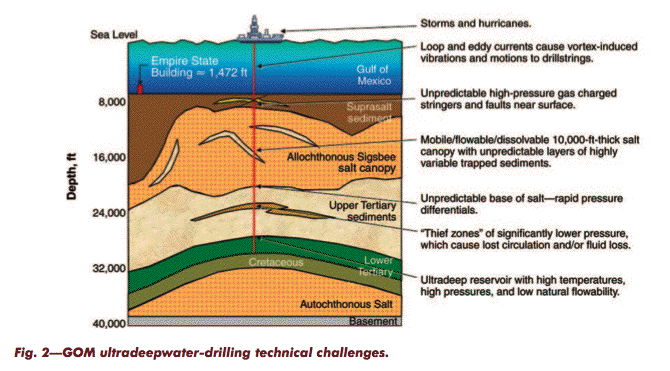
Today, to get oil you have to go deep. Really, really deep. And there are issues.
Today oil is so hard to find and produce that energy engineers have to invent radical new technologies to find and extract oil from six miles or more below the surface of the earth where pressure heats the oil to 500 degrees Fahrenheit and ordinary pipes melt trying to bring it to the surface. Usually the pressure turns the oil into gas, that is far more expensive to produce, transport, and store.
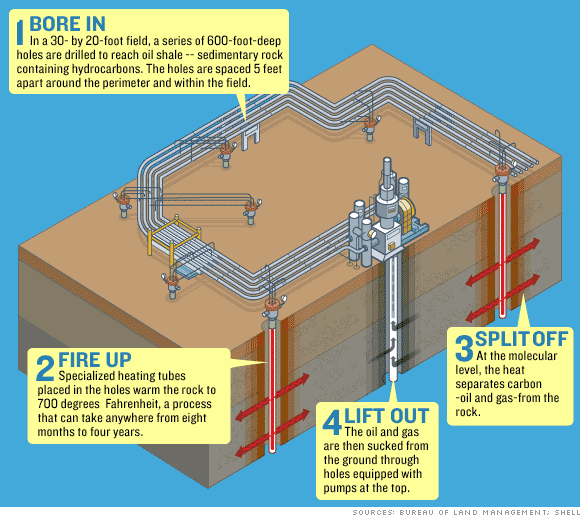
New technologies also allow engineers to extract petroleum from oil rich rock deposits called shale.
Common sense tells us that oil supplies must be growing dear if engineers can no longer draw oil from giant shallow reservoirs as they could as recently as the 1960s but are now forced to drill miles into the earth’s crust to extract oil and squeeze it out of rocks called "shale."
Valid, scientific debate raises the question of whether new exploration and production technologies will extend the production plateau period at the current 85 million barrels per oil consumption rate for a few more years, or even raise production above it.
The peak oil question is, are we 0.95 or 1.1 seconds into draining our tub of oil through the great hole of global oil consumption that took 5 million seconds to fill? Are we two, five, or ten years away from a global oil production decline? What are the implications of decline?
With these basics as background, we move on to the first chart in Robert Hirsh’s presentation.
Common sense tells us that oil supplies must be growing dear if engineers can no longer draw oil from giant shallow reservoirs as they could as recently as the 1960s but are now forced to drill miles into the earth’s crust to extract oil and squeeze it out of rocks called "shale."
Valid, scientific debate raises the question of whether new exploration and production technologies will extend the production plateau period at the current 85 million barrels per oil consumption rate for a few more years, or even raise production above it.
The peak oil question is, are we 0.95 or 1.1 seconds into draining our tub of oil through the great hole of global oil consumption that took 5 million seconds to fill? Are we two, five, or ten years away from a global oil production decline? What are the implications of decline?
With these basics as background, we move on to the first chart in Robert Hirsh’s presentation.
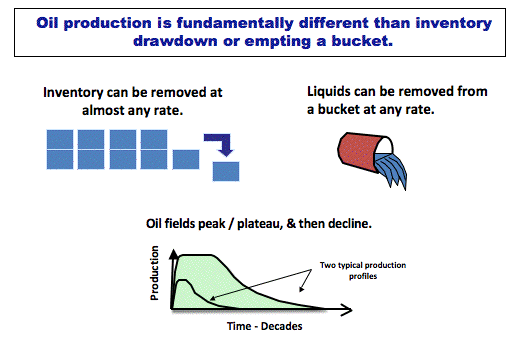
An oil field is not uniform like our mythical tub of oil. It is irregularly shaped.
Think of a milkshake on ice that you drink through a straw. Say there are 20 sips of milkshake in the glass. The first 10 sips are easy. But after the milkshake falls to the level of the top of the ice, the last 10 sips become increasingly difficult with each sip. You are forced to pull the straw up and stick it in again between the ice cubes to get at the remaining milkshake. The rate of milkshake extraction falls. Instead of a steady series of sips each sip takes more time and effort.
When you take the last sips the liquid is next to impossible to get out of the bottom of the glass, but at least you can hold the glass up and see where the remaining milkshake is, and moving the straw around costs you nothing.
When engineers extract the last oil from an oil reservoir, they rely on expensive oil exploration tools, such as satellite imagining and seismic analysis, to “see” the oil. Drilling is highly capital intensive. A single deepwater dry well in Indonesia in 2004 cost $30 million.
The cheap oil is the oil at the top of the reservoir. After that, oil extraction grows more difficult and expensive.
At iTulip we call the phenomenon of the end of cheap oil and its impact on the economy Peak Cheap Oil.
Think of a milkshake on ice that you drink through a straw. Say there are 20 sips of milkshake in the glass. The first 10 sips are easy. But after the milkshake falls to the level of the top of the ice, the last 10 sips become increasingly difficult with each sip. You are forced to pull the straw up and stick it in again between the ice cubes to get at the remaining milkshake. The rate of milkshake extraction falls. Instead of a steady series of sips each sip takes more time and effort.
When you take the last sips the liquid is next to impossible to get out of the bottom of the glass, but at least you can hold the glass up and see where the remaining milkshake is, and moving the straw around costs you nothing.
When engineers extract the last oil from an oil reservoir, they rely on expensive oil exploration tools, such as satellite imagining and seismic analysis, to “see” the oil. Drilling is highly capital intensive. A single deepwater dry well in Indonesia in 2004 cost $30 million.
The cheap oil is the oil at the top of the reservoir. After that, oil extraction grows more difficult and expensive.
At iTulip we call the phenomenon of the end of cheap oil and its impact on the economy Peak Cheap Oil.
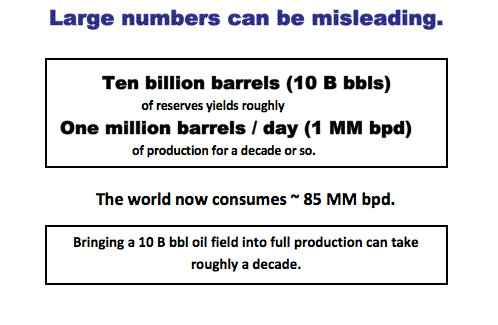
When you hear about oil reserves expressed in big numbers, remember that consumption level—the size of the hole in our tub of oil—determines how long those reserves last. Ten billion barrels sounds infinite, but the world consumes 85 million barrels a day. One 10 billion barrel oil field is only enough oil for 117 days of global consumption at that rate.
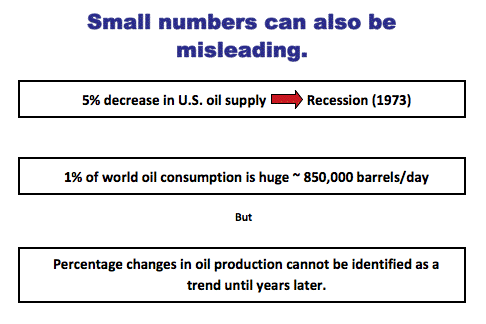
The global economy is highly oil supply sensitive. Even small disruptions in supply produce outsized economic consequences.
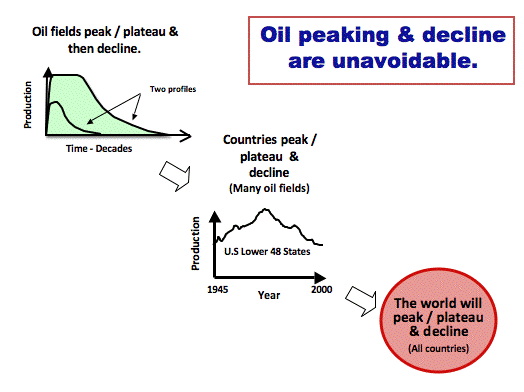
Just as nations have for decades experienced oil production peaks, plateau, and decline, the world will, inevitably, also experience and oil production peak, plateau, and decline.
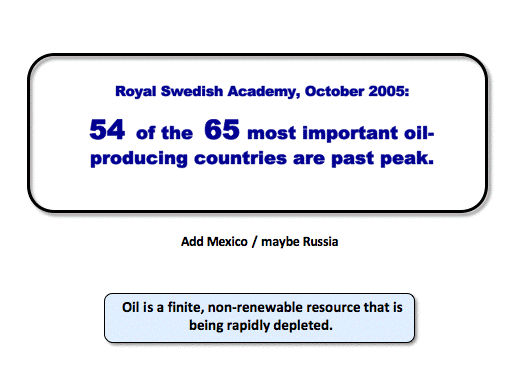
Fully 83% of the world’s major oil producing countries are past peak production and are in decline. Mexico and Russia are on the watch list.
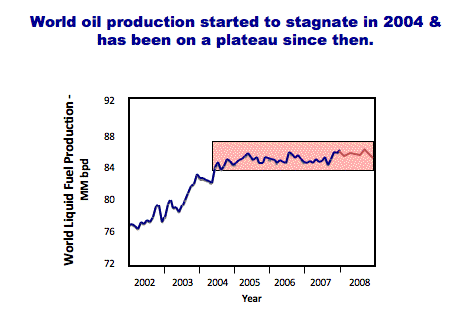
World oil production appears to have peaked in 2004 and began to plateau in a pattern of peak and plateau that occurred in 54 major oil producing countries so far.
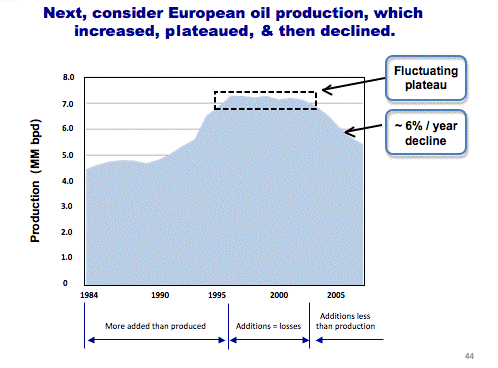
For example, European oil production peaked in 1996 then reached a plateau that continued until 2003. After that production began to decline.
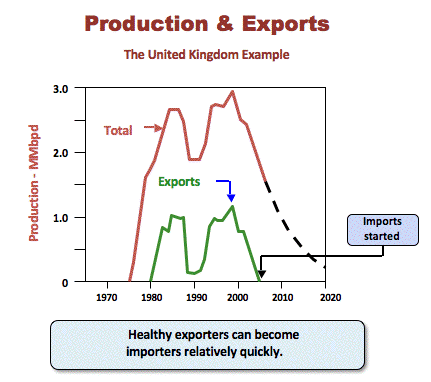
The United Kingdom serves as an example of a more extreme peak oil dynamic on a national basis. North Sea oil production peaked in 2000 and has been in rapid decline ever since. The UK became a net oil importer in 2009.
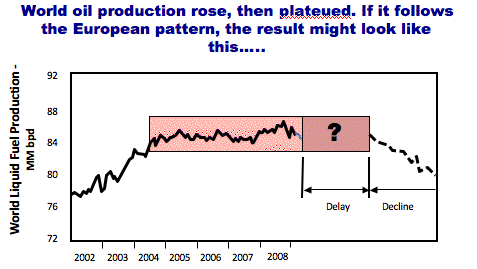
If world oil production follows the pattern of Europe’s oil production peak, the result might look like this.
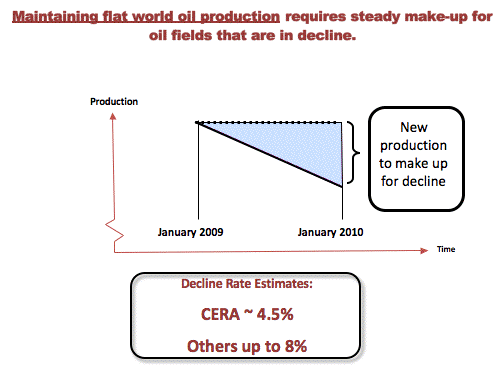
When, sooner or later, oil production peaks, estimates of the rate of decline of current oil fields globally range from the Cambridge Energy Resource Associates estimate of 4.5% per year to 8% per year by a range of other energy analysts.
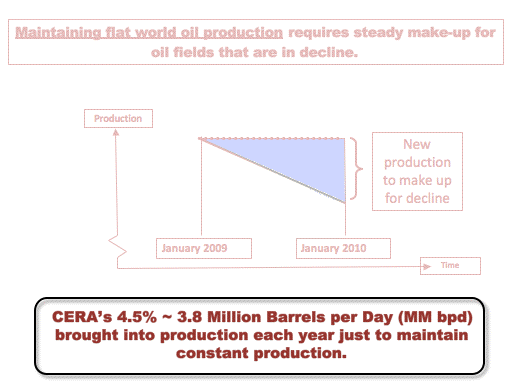
To compensate for production declines in existing oil fields, new fields have to be discovered and brought on line. CERA estimates that 3.8 million barrels per day of new oil production must come on line just to maintain the current level of the global oil production plateau.
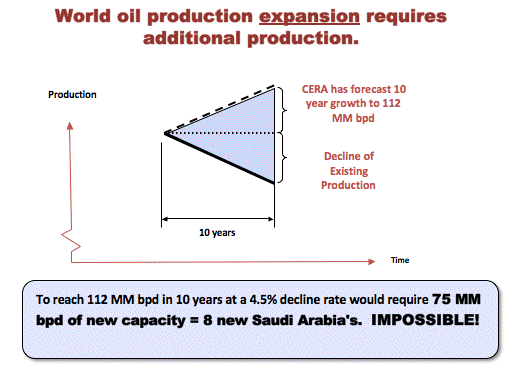
Recall the rule of thumb that ten billion barrels of reserves translates into approximately one million barrels per day of oil production. To produce 3.8 million barrels per day of new oil, as CERA says are needed to maintain the plateau level that began in 2004, the discovery and development of 38 billion barrels of new oil reserves are required. By Hirsh’s calculations, that means that over a ten-year period of 5% decline as much oil has to be found and extracted as once existed in all of Saudi Arabia, eight times over. Engineers need to find and mine oil from the earth’s crust, and squeeze it out of rocks, at a rate that is equal to the discovery of one Saudi Arabia sized oil deposit every 15 months. Hirsh believes that such an engineering feat is impossible.
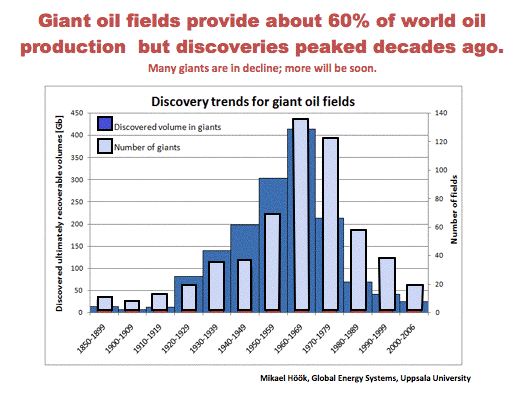
Hirsh’s assessment is justified by the historical data on oil field discovery. More than 40% of oil production comes from giant oil fields. The rate of discovery of giant fields peaked in the 1960s. While giant fields are still being discovered, the rate of discovery has fallen from over 120 per decade in the 1960s, to 24 per decade of the 1980s, to 9 between 2000 and 2007.
During this fifty year period of declining large oil field discovery, technology for oil exploration vastly improved, with satellite and other tools revealing oil deposits hidden below the land and oceans. As shallow, conventional oil fields deplete at a rate of 5% per year, optimistically, and a new Saudi Arabia sized oil deposit must be discovered and produced every 15 months to compensate for the decline. This new oil must come from a combination of a small number of giant as-yet-undiscovered unconventional oil fields and from a large number of smaller oil deposits.
During this fifty year period of declining large oil field discovery, technology for oil exploration vastly improved, with satellite and other tools revealing oil deposits hidden below the land and oceans. As shallow, conventional oil fields deplete at a rate of 5% per year, optimistically, and a new Saudi Arabia sized oil deposit must be discovered and produced every 15 months to compensate for the decline. This new oil must come from a combination of a small number of giant as-yet-undiscovered unconventional oil fields and from a large number of smaller oil deposits.
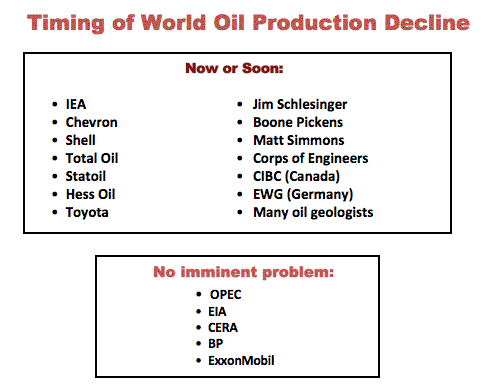
The question of peak oil production and decline is not an “if” question; it’s a “when” question. Has it already begun? If not, when? A minority of oil companies and energy research firms believe that oil production has not or will not soon peak. Most do.
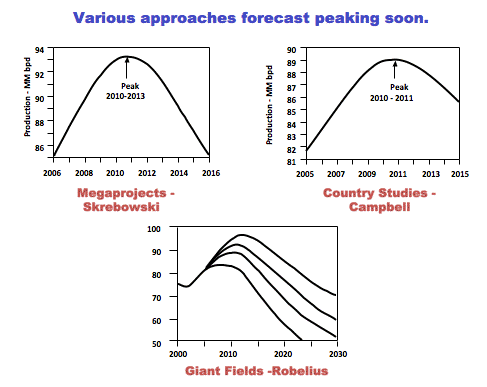
Most oil production studies put the peak of oil production at or around the year 2011.
The evidence is overwhelming that conventional world oil production peaked in 2004 and reached a plateau of 85 million barrels per day. In Part II we analyze presentations given at the conference that make the case for and against the possibility that non-conventional oil—deepwater and shale—can maintain the current production plateau for an extended period. We also look at the distortions in demand and pricing produced by the global recession.
Continuing with Hirsh’s presentation, whether the oil plateau ends in a few years or ten, surely the day will come when global oil production declines. What then? Can’t we substitute other materials for oil?
The evidence is overwhelming that conventional world oil production peaked in 2004 and reached a plateau of 85 million barrels per day. In Part II we analyze presentations given at the conference that make the case for and against the possibility that non-conventional oil—deepwater and shale—can maintain the current production plateau for an extended period. We also look at the distortions in demand and pricing produced by the global recession.
Continuing with Hirsh’s presentation, whether the oil plateau ends in a few years or ten, surely the day will come when global oil production declines. What then? Can’t we substitute other materials for oil?
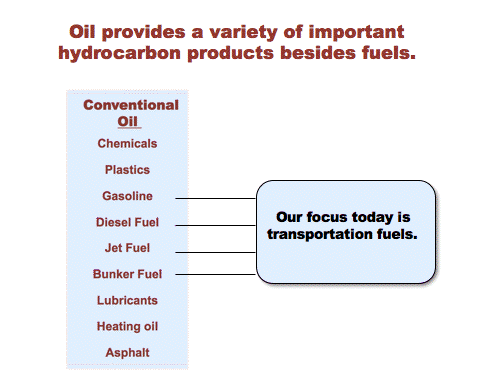
Hirsh goes on to explain another fact about hydrocarbons that few of us appreciate, that we rely on them not only for transportation but for many other industrial processes and materials as well.
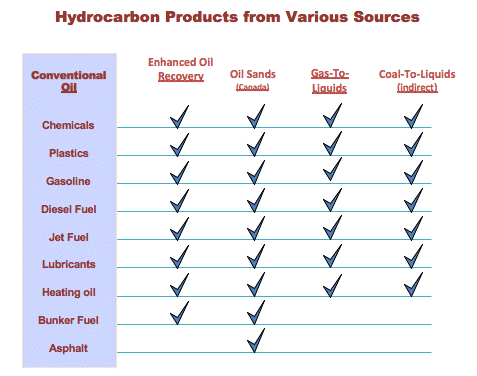
This chart shows products that we consume and the hydrocarbons that are used to make them. How many of these products can be made with substitutes? At what cost?
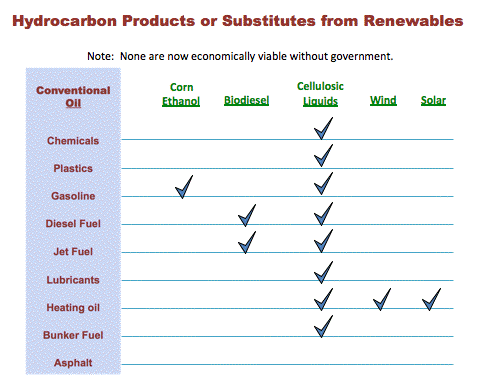
If you look around the room you are in, you will be hard pressed to find any that were not either made out of or manufactured using hydrocarbons. The substitutions suggested above do not take higher costs into account.
If hydrocarbons are about to become rare, the most obvious solution to keep them from becoming extinct is to use less for transportation so that we have more left for making products, such as plastics, that can only be manufactured using hydrocarbons.
If hydrocarbons are about to become rare, the most obvious solution to keep them from becoming extinct is to use less for transportation so that we have more left for making products, such as plastics, that can only be manufactured using hydrocarbons.
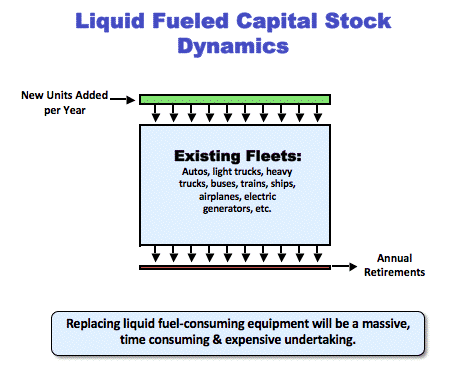
But how? The current fleet of liquid-fuel-consuming vehicles and generators— hundreds of millions of units—depend on crude oil distillates. If the end of the production plateau is upon us, how can these possibly be converted to run on non-liquid fuels within ten years or less?
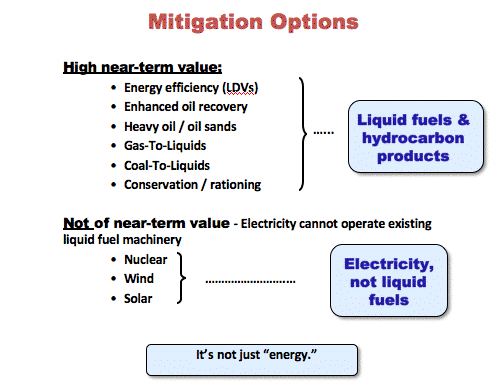
Hirsh says that the only practical solutions are: conservation and rationing, wider use of heavy oils, more intensive oil recovery from existing fields, and conversion of natural gas to liquids and coal to liquids.
Yet by Hirsh’s calculations, even if all of these methods of oil depletion mitigation are applied, assuming the optimistic 5% median annual global oil production decline rate, the world will still experience an oil shortage of 30% compared to current consumption rates.
Yet by Hirsh’s calculations, even if all of these methods of oil depletion mitigation are applied, assuming the optimistic 5% median annual global oil production decline rate, the world will still experience an oil shortage of 30% compared to current consumption rates.
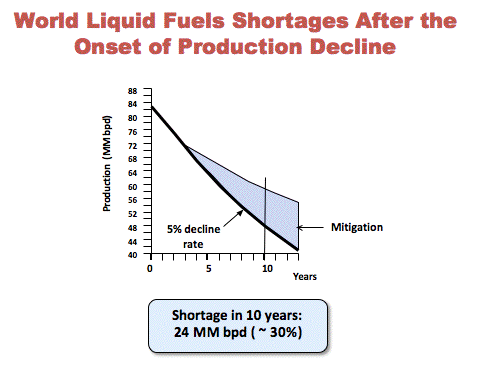
Mitigation that reduces demand, the size of the hole in the bottom of the tub of oil, only compensates for a fraction of the decline in production.
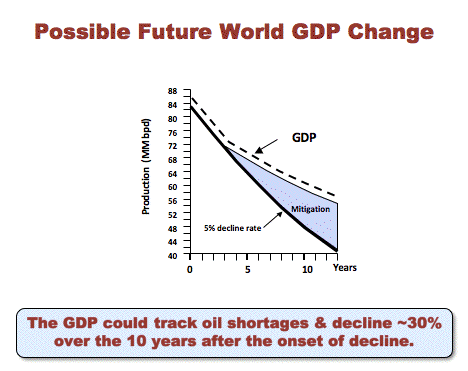
By now it should be obvious to readers that oil will not become nearly extinct like the bison on the American plains. The giant hole in the bottom of our bathtub of oil will not remain so large that the second half that collected over 31 million seconds rushes out as quickly as the first half, not in half a second but instead at a slower and slower rate.
Just like the milkshake in the glass of ice, the last five sips will be more and more difficult to find and produce over time. Oil engineers will not be able to locate and extract the oil as fast as before. Yet demand for oil will remain high because our transportation systems depend on oil. The price will rise, and the hole in the bottom of our tub will get smaller.
In economic terms, higher oil prices means that the global economy will shrink.
Hirsh’s 2008 analysis of the impact of rising oil prices on economic growth revealed an approximate 1% decline in GDP per 1% decline in the oil supply. The 30% decline in oil supply in ten years following the end of the plateau in oil production at 5% per year, implies a 30% drop in GDP in a decade. During the first three years of The Great Depression, between 1930 and 1934, U.S. GDP declined 24%. Peak Oil implies a per-capita economic decline even more severe than The Great Depression, although the economic decline may be more gradual.
Just like the milkshake in the glass of ice, the last five sips will be more and more difficult to find and produce over time. Oil engineers will not be able to locate and extract the oil as fast as before. Yet demand for oil will remain high because our transportation systems depend on oil. The price will rise, and the hole in the bottom of our tub will get smaller.
In economic terms, higher oil prices means that the global economy will shrink.
Hirsh’s 2008 analysis of the impact of rising oil prices on economic growth revealed an approximate 1% decline in GDP per 1% decline in the oil supply. The 30% decline in oil supply in ten years following the end of the plateau in oil production at 5% per year, implies a 30% drop in GDP in a decade. During the first three years of The Great Depression, between 1930 and 1934, U.S. GDP declined 24%. Peak Oil implies a per-capita economic decline even more severe than The Great Depression, although the economic decline may be more gradual.
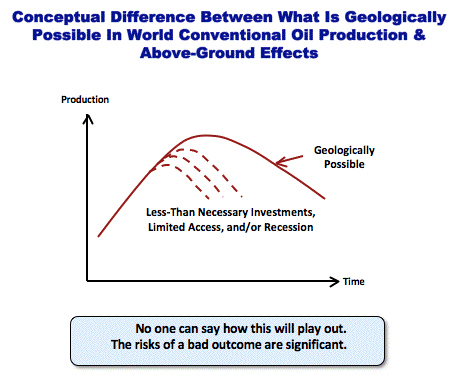
Hirsh states that the trajectory of the economic decline caused by declining oil production is unknowable because of the interaction of the economy and investment in oil exploration and production. Our analysis in early 2009 suggests that the collision of the FIRE Economy and Peak Cheap Oil will produce a series of economic booms and busts. The 30% decline will occur in an oscillation of rising prices, recession, falling demand, rising demand, rising prices, and recession.
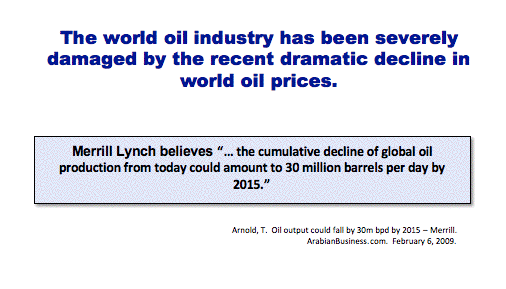
Hirsh believes, and the data support his thesis, that global oil production peaked in 2004 and remains on an 85 million barrel per day plateau. The 2008 to 2009 financial and economic crisis curtailed E&P efforts that picked up in 2005, the year after global production peaked. Merrill Lynch recently forecast a production decline of up to 30 million barrels per day by 2015. In Part II we review the detailed forecasts of various presenters. One of those forecasts accounts for the fact of rising oil prices since early 2009 even though enormous inventories of oil and gasoline exist today as a result of the global recession. Peak Cheap Oil will exaggerate the oil boom-bust cycle, and macro-economic cycles as well.
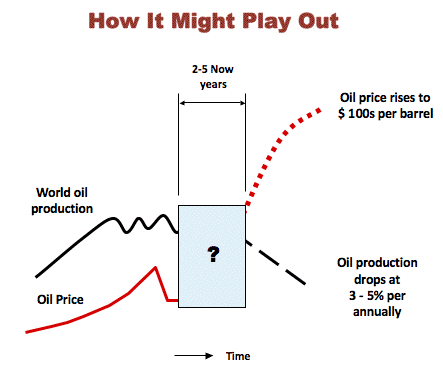
In sum, Hirsh believes that the world is five years into a global oil production plateau and that over the next two- to five-year period oil production will decline. Our view is that as the Peak Cheap Oil process continues, oil prices will rise, but not in a linear fashion. The global economy will experience a series of oil price shock recessions that will cumulatively produce the 30% decline in real GDP that Hirsh expects.
Our Peak Cheap Oil model from early 2009 represents the process in the following stylized chart. It suggests theoretical oil prices for each Peak Cheap Oil boom-bust cycle as well.
To find a critique of Hirsh’s work, we looked at several web sites that purport to debunk the peak oil case. We were unable to find any that make a logical, well-documented case.
For example, the third paragraph of the lead article on the blog peakoildebunked.blogspot.com titled “Why Robert Hirsh is Dead Wrong” states:
Every other peak oil-debunking site that we found employed careless analysis, bad math, and generally weak arguments.
Next we explore the model in the context of familiar iTulip concepts: FIRE Economy versus Peak Cheap Oil. The timing of the economic oscillations of Peak Cheap Oil is unpredictable, as is the extent of oil price increases and declines in recessions. In Part II we take a shot at estimates. Short-term factors include excess inventories due to global recession, as we have today, future supply shocks due to under-investment that we expect to see between 2012 and 2015, anti-asset price deflation monetary policy, anti-oil cost push inflation monetary policy, and dollar reserve status changes.
Special Note: It was a pleasure to see many iTulip members at the ASPO conference.
Our Peak Cheap Oil model from early 2009 represents the process in the following stylized chart. It suggests theoretical oil prices for each Peak Cheap Oil boom-bust cycle as well.
To find a critique of Hirsh’s work, we looked at several web sites that purport to debunk the peak oil case. We were unable to find any that make a logical, well-documented case.
For example, the third paragraph of the lead article on the blog peakoildebunked.blogspot.com titled “Why Robert Hirsh is Dead Wrong” states:
“Here's the fine print, from the Hirsch Report:
The blogger writes “conservation plays no role whatsoever in Hirsch's "mitigation". None. Zero.” Somehow he missed the phrase “coupled to significant increases in transportation fuel efficiency” that appears in the portion of the Hirsh report that he quotes. Nevertheless, this analysis clearly demonstrates that the key to mitigation of world oil production peaking will be the construction a large number of substitute fuel production facilities, coupled to significant increases in transportation fuel efficiency. The time required to mitigate world oil production peaking is measured on a decade time-scale. Related production facility size is large and capital intensive. (P. 6)
“Let's break that down. Note that conservation plays no role whatsoever in Hirsch's "mitigation". None. Zero. His idea of "solving" the peak oil problem is to build horrendously expensive, highly polluting facilities for producing substitute liquid fuel (CTL, GTL, heavy oil) so that everyone can continue driving their current vehicles in a completely business-as-usual fashion.”Every other peak oil-debunking site that we found employed careless analysis, bad math, and generally weak arguments.
Next we explore the model in the context of familiar iTulip concepts: FIRE Economy versus Peak Cheap Oil. The timing of the economic oscillations of Peak Cheap Oil is unpredictable, as is the extent of oil price increases and declines in recessions. In Part II we take a shot at estimates. Short-term factors include excess inventories due to global recession, as we have today, future supply shocks due to under-investment that we expect to see between 2012 and 2015, anti-asset price deflation monetary policy, anti-oil cost push inflation monetary policy, and dollar reserve status changes.
Special Note: It was a pleasure to see many iTulip members at the ASPO conference.
 |
ASPO-US Conference Denver 2009 Trip Report and analysis
• Peak Cheap Oil Cycle has displaced the FIRE Economy Bubble Cycle
• Natural Gas Mini-Bubble or
• Why banks want us to believe the U.S. has 100 years of natural gas reserves and
• The U.S. can’t fuel a fleet of liquid natural gas (LGN) powered trucks and reduce our dependence on foreign oil by 30% as some assert
• Oil prices will spike to above $150 before 2012
In October I spent an hour with reporter who was putting together a package about asset bubbles for syndication. He asked the usual questions, including the status of The Next Bubble in alternative energy and energy infrastructure that I wrote about in Harper’s Magazine.
Then I told him, as I did readers here earlier this year, that it appears that we will indeed get a "green" boom largely financed with government money, but it's not likely to develop into a full blown bubble of the kind we saw in technology stocks in the 1990s or in housing from 2002 to 2006. There's no private sector credit Ponzi machine to finance it.
Government can assist in bubble creation with monetary policy, by failing to enforce banking regulations, and by permitting new forms of credit to inflate asset prices the way securitized mortgage debt inflated housing prices, but government cannot create a colorful and exciting private market balloon out of strips of government bond burlap. My reporter appeared crestfallen.
In any case, bursts of high oil prices from the Cheap Oil Cycle will cut future asset bubbles short.
Regrettably, just as the concept of a Bubble Cycle goes mainstream, as I described it four years ago in The Bubble Cycle is Replacing the Business Cycle, the Bubble Cycle is no more.
The grim predictability of asset bubbles will be missed, with their characteristic multi-phase structure of price distortion that is ultimately mean reverting. Our Peak Cheap Oil Cycle model is far more complex and less deterministic. It will remain a work in progress at least until we get through one complete turn of the wheel, to see how monetary and currency policy adapts, but at least we are starting off with a solid, working hypothesis that we have been developing since 2006. Today we give our readers a first look. more... $subscription
iTulip Select: The Investment Thesis for the Next Cycle™
__________________________________________________
To receive the iTulip Newsletter or iTulip Alerts, Join our FREE Email Mailing List
Copyright © iTulip, Inc. 1998 - 2009 All Rights Reserved
All information provided "as is" for informational purposes only, not intended for trading purposes or advice. Nothing appearing on this website should be considered a recommendation to buy or to sell any security or related financial instrument. iTulip, Inc. is not liable for any informational errors, incompleteness, or delays, or for any actions taken in reliance on information contained herein. Full Disclaimer

Comment